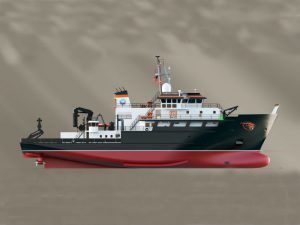
Gulf Island Shipyards to build OSU research vessel
JULY 14, 2017— Gulf Island Shipyards, LLC, a subsidiary of publicly traded Gulf Island Fabrication, Inc., has been awarded a contract by Oregon State University (OSU) to build a 193 ft x

JULY 14, 2017— Gulf Island Shipyards, LLC, a subsidiary of publicly traded Gulf Island Fabrication, Inc., has been awarded a contract by Oregon State University (OSU) to build a 193 ft x
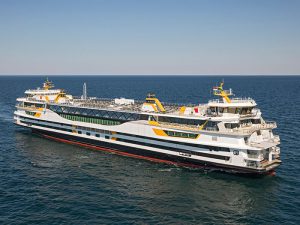
JUNE 29, 2016 — Spanish shipbuilder Construcciones Navales del Norte—La Naval — has now delivered Texelstroom, one of the world’s first hybrid RoPax ferries. The 135 m double ender has been built
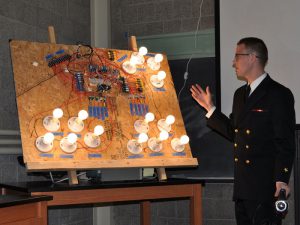
APRIL 26, 2015 — Fourteen light bulbs, representing electrical loads at different parts of campus, attached to a large plywood board lit up then, controlled by a sensor, turned off one by
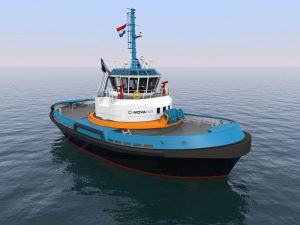
Additionally, Multraship has also agreed a deal with Damen for a new state-of-the-art ASD 3212 tug as part of its planned fleet expansion
Construction of the CRTs will begin immediately. The hulls of the vessels will be built by German shipbuilder Theodor Buschmann GmbH in Hamburg, with final outfitting carried out by Damen Maaskant Shipyards in Stellendam, the Netherlands. Delivery of the Bureau Veritas-classed vessels is scheduled for first-quarter 2017.
The Carrousel towing system consists of a towing point on a straightforward steel ring, freely rotating around the superstructure of the tug. According to Novatug, a towing load simply cannot capsize a Carrousel tug and the tug’s own hull profile can safely be used for generating braking and/or steering forces, based on the lateral resistance of the hull through the water and given the kinetic energy present in the moving tow and/or the current.
In the CRT, this towing system is combined with the advantages of the RAVE Tug (Robert Allan Ltd. – Voith Escort) jointly developed by naval architectural consultancy Robert Allan Ltd. and Voith Turbo Marine. The unique characteristic of the concept is the longitudinal alignment of two Voith drives, delivering very precise and improved force generation characteristics.
The CRTs have an overall length of 32 m, and a bollard pull of minimum 70 tonnes. Propulsion is via two Voith thruster units and two ABC main engines of 2,650 kW operating at 1,000 rpm. Free running speed is over 14 knots at 5,300 kW.
The CRT’s combination of low operational costs, speed of action and enhanced control over the tow can provide major advantages over conventional tugs, for example by widening or even removing tidal and/or weather windows for certain ports.
Novatug will offer the Carrousel Rave tugs on the basis of long-term bareboat charters, basically a financial or operational lease construction, an arrangement proven in other capital-intensive industries such as aviation. Its customer for the first two units is its parent, Multraship.
Leendert Muller, managing director of Multraship, says, “Safety is always our overriding objective, and that it is why we have opted wholeheartedly to produce the Novatug CRT. This new tug design, for the first time, eliminates what has always been the most significant threat to safety in towing – the risk of capsizing under a tow load. The benefits in terms of efficiency and flexibility, meanwhile, are also enormous.”

Carrousel Rave Tug
ASD TUG
The new state-of-the-art ASD 3212 tug acquired by Multraship — the Dutch-flag, LR-registered Multratug 31 — was built at Damen Song Cam, Vietnam. A sister vessel to Multratugs 19, 29 and 30, it will operate mainly in the Western Scheldt area. It has a maximum bollard pull of 83.2 tonnes and a maximum speed of 15 knots.
The 453 gt vessel is powered by two Caterpillar 3516C engines and has two Rolls Royce Azimuth thrusters and a 2,800 mm-diameter controllable pitch propeller.The vessel’s deck layout features a hydraulically driven escort double drum winch forward and single drum aft, and a 25 mt deck crane. There are two one-man cabins, four two-man cabins, a mess room and galley.
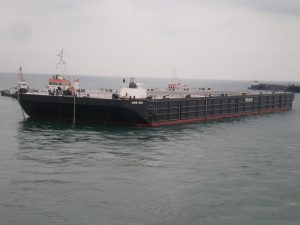
SEPTEMBER 29, 2014 — Crowley Maritime Corporation’s solutions group has received the first two of potentially four, new heavy-lift, ballastable deck barges (HDBs) for use by clients in the Asia-Pacific region. The
MAY 13, 2013 — The European Commission today unveiled what it calls “a maritime strategy for the Atlantic,” it has adopted an “action plan to revitalize the marine and maritime economy in
MARCH 25, 2013 — Invented by Dennis Knox of OSSeas Consulting, Tortola, British Virgin Islands, the SHC Wavedancer is a concept for a submersible hull catamaran. It is described as “essentially a
OCTOBER 23, 2012 — Wave energy technology specialist Ocean Power Technologies (Nasdaq: OPTT), Inc. is benefiting from a Japanese Government decision to place far more emphasis on renewable energy following the Fukushima
China’s COSCO (Nantong) Shipyard Group Co., Ltd. has commissioned Siemens Marine Solutions to equip a new wind turbine installation vessel with diesel electric propulsion systems, power supply equipment and an integrated automation
Neptune, based in North Ferriby, East Yorkshire, England, has successful completed a series of rigorous in-water tests on the full-scale demonstrator of its Proteus NP1000 tidal stream power generator, it is now seeking a trade partner, which could be a shipyard or heavy engineering concern, who can demonstrate the capability to fabricate and build future production devices.

Weighing more than 150 tonnes and 20 m in length with a beam of 14 m, the Proteus NP1000 consists of steel buoyancy hulls, a vertically mounted turbine with a 6 m x 6 m rotor, and computer controlled flow vanes within a venturi duct.
Despite its size, the floating pontoon design means that the Proteus is largely unobtrusive when deployed, with more than 80 per cent of its bulk always hidden from view under the water. This low environmental footprint has now been approved by the U.K. Department of Energy and Climate Change.
Test data indicate that when optimized for the tidal stream the Proteus NP1000 will be able generate at least 1,000 MWh/year. To put this into context the projected output would be enough to meet the energy needs of more than five hundred homes.
The recent tests included the powering-up and generation of electricity as proof of the commercial potential of the device’s power curve. Tow testing was carried out in three phases during August, September and October in Hull’s Albert Dock. The third set of experiments provided the final, critical, “proof of concept” hurdle and the device will now be prepared for commercial deployment in early 2011 at Sammy’s Point in the Humber.
Commented Nigel Petrie, Chairman, Neptune Renewable Energy Ltd (NREL): “We are delighted to have successfully come through the in-water testing phase for the Proteus Demonstrator which paves the way for the device to be commissioned shortly and installed, with the first electricity delivered in 2011. Having reached this key milestone, at Neptune we are now looking to identify a trade partner who is able to demonstrate that they have capability to work with us to manufacture and deliver future devices.”
Mr. Petrie said the company is also seeking equity providers to work with in order to help fund a series of arrays of the tidal stream power generators which are planned for the Humber in 2011 and 2012.
You can email Neptune at enquiries@neptunerenewableenergy.com